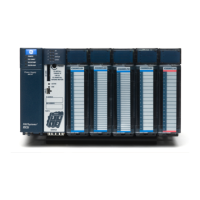Chapter 7. PID Built-In Function Block
356 PACSystems* RX7i, RX3i and RSTi-EP CPU Programmer's Reference Manual GFK-2950C
7.4.1 Derivative Term
The Derivative Term is Kd (word 7 of the reference array) multiplied by the time rate of change of the
Error term in the interval since the last PID solution.
Derivative = Kd * Δerror / dt = Kd * (Error – previous Error) / dt
where
dt = Current controller time – controller time at previous PID solution.
Two bits in the Config Word (word 13 of the reference array) affect the calculation of Δerror: Error
Term Mode and Derivative Action. For additional information about the operation of these bits, refer
to Config Word above.
7.4.2 Error Term Mode
The sign of the Error term is determined by the value of a mode bit in the reference array for the PID
function.
In reverse acting mode, the change in the error term is:
Δerror = (Error – previous Error) = ΔSP – ΔPV
where
ΔPV = (PV – previous PV), and ΔSP = (SP – previous SP).
However, in direct acting mode, the error term is (PV – SP), the sign of the change in the error term is
reversed:
Δerror = (Error – previous Error) = = ΔPV – ΔSP.
7.4.3 Derivative Action on PV Bit
By default, the change in the error term depends on changes in both SP and PV. If SP is constant,
ΔSP = 0, and SP has no effect on the derivative term. When SP changes, however, it can cause large
transient swings in the derivative term and hence the output. Loop stability can be improved by
eliminating the effect of SP changes on the derivative term.
To calculate the Derivative based only on the change in PV, set bit 2 of the Config Word to 1. This
modifies the equations above by assuming SP is constant (ΔSP = 0).
7.4.4 Combined Operation of Error Term and Derivative Action Modes

